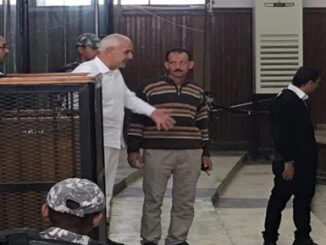Egypt, which has one of the most alarming levels of pollution in the Middle East, is in urgent need to preserve its green spaces. Instead, government bodies are almost systematically razing Cairo’s green lung under the pretext of developing roads or building new roads leading to the new administrative capital.
According to Al-Ahram, a government-owned newspaper, on 25 May, the Egyptian citizen’s share of green spaces is only 1.2 square meters against a global average of no less than 15 meters, which is a very low rate that has serious health and environmental consequences.
Also, the official data issued by the Central Agency for Public Mobilization and Statistics (CAPMAS) has revealed that the green spaces that already exist in Egypt are less than 10% of the spaces that should be available for the current population.
This low statistic has fueled controversy over the Sisi government’s continued uprooting of trees and removal of green spaces, especially in the capital, Cairo, under the pretext of establishing traffic axes, bridges, and new roads, to solve traffic jam, or new roads to the new administrative capital.
The plan to develop new roads began more than two years ago, and included the removal of many trees in several neighborhoods, such as Heliopolis and Nasr City, through the ancient neighborhood of Maadi, and the removal of the entire Arab Al-Mohammadi Park in downtown Cairo in August.
Heliopolis
In the traffic-choked megacity of Cairo, the historic Heliopolis district has long stood out for its leafy boulevards, but over the last few years construction crews have been cutting new highways through it and uprooting its century-old trees.

Over the last few years, the military’s engineering arm has been building highways worth billions of pounds to link Cairo with the under-construction new capital that is about 45 kilometres (30 miles) to the east.
Known as the New Administrative Capital, it is set to boast skyscrapers, a new presidential palace, dozens of ministries and flats for tens of thousands of civil servants, with the aim of easing Cairo’s chronic overcrowding and air pollution.
The first victim of the mega-project, however, is Heliopolis, built in 1906 by Baron Edouard Empain, a wealthy Belgian entrepreneur who settled in Cairo while working on modernizing its nascent railways.
He designed the area with wide streets and elegant buildings that meld various design motifs, as embodied in his impressive palace, which is still standing.
As one of Egypt’s most expensive suburbs, Heliopolis also houses powerful institutions including the presidential palace, the military academy and several other armed forces facilities.
But now Triomphe Square and the lush arterial avenues of al-Nozha and Abou Bakr al-Seddik, marked by palm trees and ficus plants, have become sites for about a dozen routes out of the suburb.
Under the pretext of street development or building a new capital in the desert east of Cairo, thousands of trees have been cut and thousands os square meters of green spaces have been razed, with at least six new highways leading there cut right through Heliopolis, an upmarket district with tree-lined streets laid out in the early 1900s in the style of a mini-European metropolis.

Rassd News Network on published a post describing how Heliopolis Streets are developed, attaching two photos of the Hegaz Street, commenting: Photos taken before and after the government’s development of the Hegaz Street in Heliopolis. What do you think of such development process?
This massacre of trees and green spaces was described by an Egyptian writer in in a column shared widely online as “the raping of a suburb … with its guts spilling out”.
Merryland Park in danger
On 19 September 2021, Middle East Observer published a report titled, “Heliopolis’s historic “Merryland Park” in danger”.
The historic Merryland Park, the largest park in Heliopolis district, is currently in great danger, with a plan to completely destroy a large part of it and cut down a large number of its 100-year old tall and shady trees.
Merryland Park is located on an area of 50 feddans (acres) and dates back to 1949 during the reign of King Farouk. At the time, the Merryland Park was incepted under the name “Horse Racing Club”.
In 1952, the club was transferred to the Al Shams Club area, where it was called the Equestrian Club.
In 1958, Merryland was given its current name. At the time it housed casinos and a roller-skating rink.
In 1980, an arboretum was established, and later the Alex Company built three cafeterias to serve visitors. A lake for ducks and a mini-zoo were also built. Operating hours were from 8am to 5pm because the park had no proper lighting system.
The Sinbad Tourist Company won the management and operating rights to Merryland in 1997 and turned the park into a leisure venue by building international restaurants, an amusement park, a pool for a show of dolphins and seals and vast gardens.
The Merryland Park included many tall and shady trees, and contained a lake with small boats sailing in it. In 1963, a casino was added to the park.
Maadi
Also, last month, the residents of Maadi neighborhood, south of Cairo, the most wooded neighborhood in Cairo, criticized the government’s decision to remove agricultural nurseries and infiltrate the neighborhood under the pretext of establishment of a new traffic axis.
The residents were up-in-arms after the Egyptian Ministry of Transportation announced a new highway development that may result in the deforestation of some of Maadi’s most renowned areas.The Ministry of Transportation announced on 6 June 2021 the new project, named ‘Al Gazaer Axis’ (Algeria Axis), along with two other new projects to be implemented to tackle traffic congestion
The residents launched a campaign to collect signatures to stop the plan to implement the Algeria Traffic Axis, as the campaign organizers said this road would change the nature of the place, its identity, its urban fabric and its quiet green nature, tearing the neighborhood into two halves.
The Tree Lovers Association, one of the oldest public environmental associations in Egypt, as it describes itself, called for a reconsideration of the axis’s path and taking into account the urban fabric of the neighborhood, and areas with a historical and cultural dimension; because it would also damage its calm green nature, and even destroy its perennial tree wealth.
Residents of Maadi have been posting on social media to call for action against this project, including actor Karim Kassem, television presenter Layla Farouk, and singer Shahira El-Khatira, using the hashtag of “Maadi Refuses the Axis”.
“It’s the quality of life we are campaigning for in line with the National presidential target as well in sustaining and creating a better quality of life to all Egyptians. We are defending our right for this life and preserving a beautiful garden suburb in Egypt which is considered an icon for sustainability and cultured heritage,” said Walaa Afifi, one resident of Maadi and an active member in the community to Egyptian Streets.
The proposed ‘Al-Gazaer Axis’ project will include a motorway that is planned to span from the National Museum of Egyptian Civilization (NMEC) in Old Cairo and will end at Torra Road and Autostrad Road, passing through the Degla area.

One of the areas that will be most affected by this project is Street 250 in Maadi, which is approximately one kilometer long and is filled with hundred-year-old trees on both sides. It is also known for hosting flower and street vendors frequently visited by local residents and visitors from other areas in Cairo.
A number of Maadi residents have argued that the areas which will be affected by the new project are protected and registered landmarks of Maadi, and therefore the project is unlawful. Residents of Maadi have also argued that the project will result in a series of other consequences, including massive deforestation of large areas of Maadi, and that ultimately it will not solve traffic issues in the area.
“Since the roads of Maadi are already narrow, and the flow of traffic is already dense, this axis project will, unfortunately, result in more congestion,” said Zeina Saafan, one of the admins of the newly-founded Save Maadi Instagram page, to Egyptian Streets.
The Save Maadi page has launched an online petition to gather signatures in an attempt to prevent the implementation of the new project and to preserve the greenery in the Degla area and on Street 250. Nearly 14,000 people have signed the petition since it was launched in June 2021.
Maadi dates back to the late 19th century when Egypt was under the rule of Khedive Ismail (1830-1895). In 1904, Maadi started to take its current shape when the railway between Sayeda Zainab and Helwan was built and the Mosseri cousins, famous businessmen, decided to resell the land back to Egyptian Delta Land and Investment Company.
Maadi was unconventionally planned by the English-Canadian Captain Alexander J. Adams; it eventually grew into a distinctive town that surrounded the railway. It is currently known for being culturally diverse and home to many expats living in Egypt. Some of its most famous districts include Corniche Maadi, Sarayat Maadi, Degla Maadi, Zahraa Maadi, Old, and New Maadi.
Thousands of square meters of green space, including trees and grass, have reportedly been razed over the past few years
Gharbia
In Gharbia (Central Delta) north of Cairo, the governorate announced on its official Facebook page in early August, putting up more than 1,500 trees for sale in a public auction, including 895 camphor trees in the vicinity of Tanta, in addition to various other trees.
However, the announcement sparked the outrage of social media activists, considering it a continuation of the series of uprooting old-aged trees, and unnecessarily distorting the cultural landscape of many roads and neighborhoods.
The above tweet says: A war on nature! Gharbia Governorate announces a public auction to sell a number of trees located on public roads in the governorate’s cities, after removing them, on the pretext of concern for the lives of citizens and fear of falling on passers-by due to the wind.
Subsequently, lawyer Ahmed Al-Saeedi submitted a complaint to the Prosecutor-General against the governorate officials, and said in press statements that the announcement “contradicts Articles 162 and 367 of the Penal Code … and also violates Article 2 of the Terrorism Law, which criminalizes harming the environment or natural resources.”
The cutting down of trees throughout Egypt to make way for new urban projects has always angered the public and sometimes led members of parliament to call for new measures to protect Egypt’s trees.
Parliament member Anisa Hassouna called on the government, particularly the Ministry of Environment, to prevent what she called the massacre of trees on Egypt’s streets. “It seems that the government doesn’t like fresh air,” she was quoted by the local media as saying.
Her statement came after massive tree cuts across several cities, such as on Ahmed Fakhri Street in Nasr City, on 17th Street in the Mokattam district in southeastern Cairo, in Ismailia and various streets in New Heliopolis. Most of the removals happened in September and October so builders could construct new residential areas, enlarge roads or build bridges.
Hassouna said that trees must be protected for environmental reasons as well as for their psychological impact on citizens. She pointed out that some of trees were historical landmarks, saying, “The Bengali fig tree on Mohammed Ali Street in Ismailia was where Charles de Gaulle [spoke] in 1941.”
She said that Egypt’s gardens and parks are being taken for granted and neglected. “For instance, Cairo’s Maadi Garden is closed to the public for no reason. The children of Egypt have the right, like any other children in the world, to sit in public parks without paying a fee. The trees carry the memories of citizens of those neighborhoods,” Hassouna said.
Sherine Farag, a member of the parliament’s environmental committee, blamed the Ministry of Environment for the destruction of trees.
She stressed that it was the Ministry of Environment’s role is to preserve trees, as it is the body authorized by law to take judicial action in cases of violations. The ministry has the power to stop projects that threaten the environment, she said.
The head of the Egyptian Tree Lovers Association, Asmaa El Halougi, said, “The world is witnessing a violent climate change due to global warming and it is important to maintain trees.”
She explained, “In any project that is being carried out to expand streets or build bridges or other projects, reforestation experts are not consulted. Drilling is done around the trees without any protection, causing their death after a while.”
Halougi added that contractors employed by the government for huge national projects possess the necessary equipment and means to transport trees and have them planted elsewhere, but this is not happening.
She said that in one of the projects in Ismailia, nine trees out of 340 were supposed to be removed. “The contractor wanted to cut down all trees. Had it not been for the association that called on the governor to stop it, … This is one example in many other projects, in which contractors seek to make profits by selling trees to coal mines and other timber businesses,” she said.
The state’s position on green spaces has become questionable and ambiguous, according to Michael Hanna, the writer interested in architectural heritage. He added that while the authority is adopting an initiative for increasing green spaces, removing trees and razing green spaces are repeatedly taking place in multiple places of the country.



